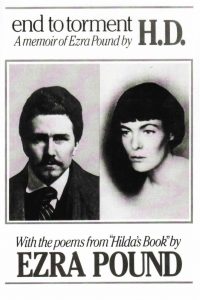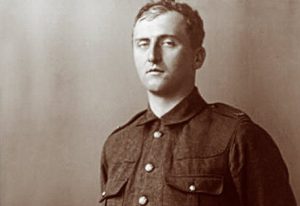We all know who Ezra Pound and H.D. are (it’s totally okay if you don’t, because I didn’t at first either. Here’s their photos so you get an idea of who we’re talking about), but did we know that in one point in time they were romantically involved? Yeah, I know, crazy. Long, long, time ago before H.D. and Richard Aldington, we’re going to call him R.A because that’s what H.D. called him, ever existed. Pound met her at a party and let’s just say they really hit it off there and became romantically involved. No one really knows why they stopped dating, they just did. I would bet it’s because Pound is an obsessive-stalker guy, but we’ll get more into that later.
H.D. and R.A. were falling in love with another right under Pound’s nose, but he never could quite grasp that idea around his head. I find this extremely hard to believe because the two were inseparable. Convinced that Pound was just in denial at this point. In September of 1912, the couple, separately, attended the British Museum tea-room. Just because H.D. did not go to the tea-room with R.A. does not mean she did not go alone; she went with… you guessed it, Ezra Pound. I don’t know about y’all, but I would not be okay with my girlfriend coming to this kind of event on her ex-boyfriend’s arm like a couple. Hey, that’s just me. Back to the point. So while they were here, H.D. showed her poems to Pound and he was incredibly impressed. He signed them “H.D. ‘Imagiste’” and sent them off that October to Poetry. Then Pound coined the phrase and term “imagiste” in 1912 and became the face of modern day poetry. Or did he?
In November 1912, three of R.A.’s poems appeared in Poetry as Imagist works, whereas H.D.’s poems did not appear for another two months later in January 1913. Yikes! When we think imagist, we think Pound, not R.A. But the movement started even before the two of them. Plot twist. I know, I know. I’m just dragging you all over the place with this one. The ideas were developed by T.E. Hulme along with the Poets’ Club in 1908. He initially created the Poets’ Club to further advance his ideas of image and expose and share this idea with other intellects of his time. They met once a month to share original pieces and everything, next thing you know, boom: the imagist movement. You’re probably wondering how in the hell did R.A. and Pound get involved with imagism four years later. Well, Pound was introduced to the idea at the Café Tour d’Eiffel. This started Hulme and Pound’s infamous feud. Majority of the tension comes from Pound trying to claim credit for Hulme’s contribution to poetry and well after his death. (See, that’s that obsessive thing I was talking about). As you can tell in the photo of Hulme below, he just looks like someone who is tired of Pound’s shit.
Despite who truly deserves to take credit for the idea, they all agreed on one thing: that the goal of imagist poetry was to observe, admire, and appreciate detail through words and rhetorical devices. Hulme believed that because image was the untouched material of experience, we should appreciate it as such. Pound expanded on this idea and set forth guidelines that defined imagist poetry. Can you believe this guy? Did even coin the damn phrase, but is going to determine what is and isn’t imagist poetry. Somebody should have put a stop to his madness. Back to the point, one of those defining guidelines was “to use absolutely no word that does contribute to the presentation” to ensure exactness and precision in the description. Genius. Controlling, but genius. Speaking of Pound and all of his greatness, below is an example and excerpt from one of his pieces in “In a Station of the Metro”.
The apparition of these faces in the crowd;
Petals on a wet, black bough.
-Ezra Pound
Here, Pound uses both descriptive and rhetorical devices to express to the audience the images he sees before him. Now, does that not sound exactly like the picture? That Ezra is good, I tell ya.
In 1914, an anthology about imagistes was created and edited by Pound (shocker) was published. Works in this included, you guessed it, R.A. and H.D. But by the time of the anthology, a new face was seen as the leader of the movement, and this time, it was a female! Her name was Amy Lowell and she basically stole the spotlight from all the men like women normally do. Of course Pound had some excuse to defend himself, once again. This time he was claiming that the only reason he even invented imagism was to launch H.D.’s career. *room gasps*
How dare Pound take such credit?! Rumors say that this claim happened right after H.D. and R.A.’s wedding. The couple actually expressed their discomfort with Pound’s intrusive behaviors and actions in their respected books. Can you believe Pound moved in across the hall from them? Across the hall! (See! That’s that stalker thing I was talking about earlier). Seriously Pound? You cannot possibly still be that into her. Don’t get me wrong, H.D. is a catch, but stalking? That’s an all-time low; even for you. The two agreed that they worked best when Pound was at a distance. Rumors say that the “influence” Pound had on H.D. wearied off before it even started and that she’s grown into a poet on her own. But he claimed to have helped lau—okay.
What we’ve learned today is that: the creator of imagism poetry still remains a mystery, imagism poetry is simplistic in it’s message, but complex in its description, and Ezra Pound is a lunatic. You would think with his knowledge in imagery that he’d be able to notice that he honestly looked crazy out there for all those years. I expected better from you Pound. We all did.
-D.C. Imagiste Enthusiast
“A Brief Guide To Imagism”. A Brief Guide to Imagism. N.p., 2017. Web. 12 Feb. 2017.
Brinkman, Bartholomew. “Making Modern “Poetry”: Format, Genre And The Invention Of Imagism(E).” Journal Of Modern Literature 32.2 (2009): 20-40. Academic Search Complete. Web. 31 Jan. 2017
Castellitto, George P. “Imagism And Martin Scorsese: Images Suspended And Extended.” Literature Film Quarterly 26.1 (1998): 23. Academic Search Complete. Web. 1 Feb. 2017.
Drobot, Irina-Ana. “Two Versions Of Young Woman At A Window By William Carlos Williams: Which Version Is More Imagist?.” Scientific Journal Of Humanistic Studies 6.11 (2014): 55-56. Academic Search Complete. Web. 1 Feb. 2017.
Hakutani, Yoshinobu. “Ezra Pound, Yone Noguchi, And Imagism.” Modern Philology 90.1 (1992): 46. Academic Search Complete. Web. 31 Jan. 2017.
Jackson, Wallace. “To Look”: The Scene Of The Seen In Edward Hopper.” South Atlantic Quarterly 103.1 (2004): 133-148. Academic Search Complete. Web. 1 Feb. 2017.
Skaff, William. “Pound’s Imagism And The Surreal.” Journal Of Modern Literature 12.2 (1985): 185. Academic Search Complete. Web. 1 Feb. 2017.
(Translator) Henri Bergson, Introduction to Metaphysics, Macmillan (London, England), 1913.
Zilboorg, Caroline. “HD And RA: Early Love And The Exclusion Of Ezra Pound”. Imagists.org. N.p., 2017. Web. 12 Feb. 2017






